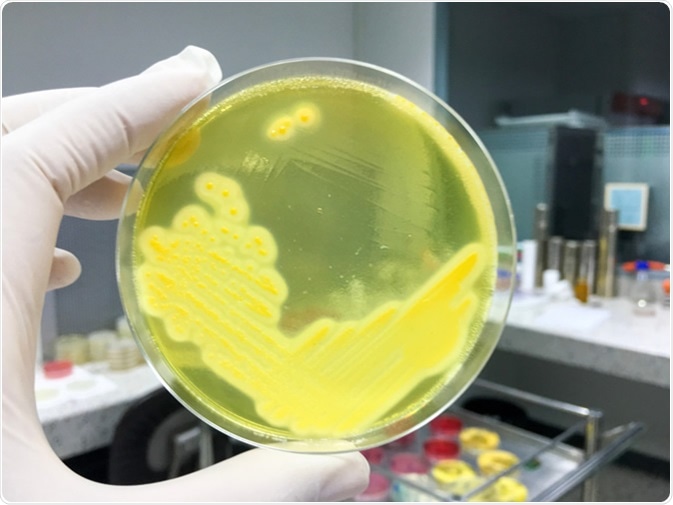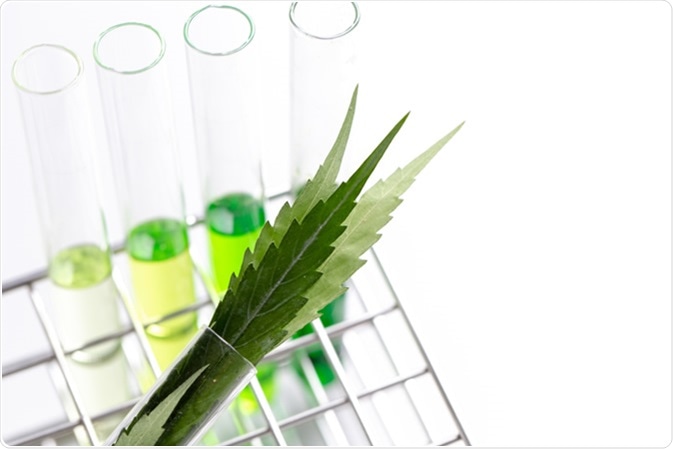Antibiotics are becoming less effective in the fight against microbial infections. Their overconsumption and misuse, for example as growth promoters in the food industry, have been linked to a rise in antibiotic-resistant strains such as methicillin-resistant Staphylococcus aureus (MRSA) and Mycobacterium tuberculosis XDR-TB.

Staphylococcus aureus grow on Mannitol salt agar. Image Credit: Pattikky / Shutterstock
In the last 30 years, scientists have only discovered one new class of antibacterial agents, and the need for new therapeutics is pressing. Plant-derived phytochemicals have therefore been studied extensively over the past decade.
Cannabis Found to have Potential in Fight Against Microbial Infection
For decades, research has shown that marijuana (Cannabis sativa) may have antimicrobial properties. Since the 1950s there have been several studies in this field, including extensive research into C. sativa as an antitubercular agent and as antiseptic for oral and skin applications.
However, the phytochemistry of cannabis was not well understood at that time, and the prevailing anti-drug rhetoric of the era presented barriers to research on cannabis compounds.

Analysis of Cannabis in laboratory. Image Credit: Rattiya Thongdumhyu / Shutterstock
Marijuana abuse as a recreational drug has at the same time been linked to an increase in infections. Studies have shown that inhalation of C. sativa interferes with nitric oxide (NO) production by pulmonary macrophages, leading to an impairment to the respiratory defense mechanism.
NO endows macrophages with cytotoxic or cytostatic activity against different infectious agents such as bacteria, viruses, fungi, and against tumor cells. Regular use of marijuana has been also linked to immunosuppression.
So if the abuse of cannabis is linked to an increased chance of infection, can antimicrobial properties be extracted?
Studies on C. sativa and the Endocannabinoid System Show Promise
It is known that the endocannabinoid system (ECS) is involved in the regulation of several physiological processes, but its role in the immune response is still not properly understood. Paradoxically, C. sativa is known to contain powerful antibacterial agents but is also linked with a marked decrease in protection against bacterial infection. The question is, how and why?
Cannabinoids, which act on receptors in the ECS, have been shown to alter the function of immune cells in vitro and in vivo. There is now a wealth of evidence that the CB2 receptor in the ECS is connected to a variety of functions of the immune system.
Particularly, it seems to play an important part in inflammatory processes. Understanding these processes could yield salient insights into how cannabinoids act upon the immune system, and by extension how they might come in useful as antimicrobial agents.
In a 2008 study, Appendino et al. discovered that all five major cannabinoids (cannabichromene (CBC), Δ9-tetrahydrocannabinol (Δ9-THC), cannabigerol (CBG), cannabidiol (CBD), and cannabinol (CBN)) exhibited potent activity against various strains of MRSA.
The research team concluded that these were the most likely antibacterial agents in C. sativa. Testing different chemical modifications of the cannabinoids, the investigators observed that an introduction of a prenyl moiety did not change the antibacterial properties.
However, methylation and acetylation of the phenolic hydroxyls, as well as esterification of the carboxylic group of pre-cannabinoids, were deleterious to the antibacterial properties.
Overall, the cannabinoids displayed high potency, which meant that clearly there was some mechanism at work that needs more research to be fully understood.
A New Class of Antimicrobial?
There are indications that the cannabinoids mainly serve as lipid affinity modulators, consequently changing the lipids’ bioavailability.
With an increasing number of studies on C. Sativa, an especially useful source of antimicrobials because of its high proportion of non-psychoactive cannabinoids, an understanding of the cannabinoid activity against microbial infections is coming closer. The potential applications could be revolutionary.
There are also properties of the cannabinoid anti-infective phenotype which make it an excellent candidate for both antibacterial disinfectants and cheap, biodegradable toiletries. This is especially useful considering the environmental profile and impact of current substances in common disinfectant usage.
Clearly, more research needs to be done into the antimicrobial properties of cannabis. As antibiotic resistance is spreading throughout the world, there is a need to find alternative antibiotics, and the results of studies carried out over the past decade into these properties could be a promising development indeed.
Sources
- Appendino, Giovanni et al., Antibacterial Cannabinoids from Cannabis sativa: A Structure−Activity Study. J Nat Prod 2008, 71 (8), 1427-1430. https://doi.org/10.1021/np8002673
- Hernández-Cervantes R. et al., Immunoregulatory Role of Cannabinoids during Infectious Disease. Neuroimmunomodulation 2017, 24, 183–199. https://www.karger.com/Article/FullText/481824
- Cabral, G.A. and Griffin-Thomas, L., Emerging Role of the CB2 Cannabinoid Receptor in Immune Regulation and Therapeutic Prospects. Expert Rev Mol Med 2009, 11, e3. https://www.ncbi.nlm.nih.gov/pmc/articles/PMC2768535/
- A New MRSA Defense, MIT Technology Review (2008) https://www.technologyreview.com/s/410815/a-new-mrsa-defense/
Further Reading
Last Updated: Apr 13, 2020